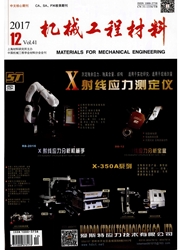

 中文摘要:
中文摘要:
采用光学显微镜、扫描电镜等分析了镁合金铸轧板坯中心线偏析区域的显微组织与微区成分;用有限差分法模拟了镁合金铸轧过程中的凝固传热与流动过程;在此基础上分析了镁合金铸轧板坯中心线偏析的形成原因与抑制方法。结果表明:中心线偏析区域的铝、锌溶质元素富集,锰元素在该区域内贫化,该区域的显微组织由细小均匀的等轴晶组成;在铸轧过程中,镁合金熔体在轧辊表面形核,并沿传热方向形成发达的柱状晶,凝固界面发生溶质再分配,溶质在凝固前沿特别是在全凝固点富集,在后续轧制变形过程中形成中心线偏析;铸轧速度显著影响铸轧凝固传热与流动过程,调整铸轧速度将全凝固点位置控制在合理位置时,可利用供液端过热镁合金熔体引起的强迫流动,改善镁合金铸轧凝固过程中的溶质扩散条件,从而抑制中心线偏析的形成。
 英文摘要:
英文摘要:
The microstructure and micro-area chemical composition of central-line segregation m magnesmm alloy cast-rolled strip were investigated by optical microscopy, scanning electron microscopy, etc. The heat transfer in solidification process and flow process were analyzed by finite difference method. Based on the above, the forming reasons and control method of central-line segregation in magnesium alloy cast-rolled strip were analyzed. The results indicate that solute elements of A1 and Zn were enriched and Mn was diluted in the central-line segregation area. The area's microstructure was composed of equiaxed grains with fine size. During the casting and rolling process, magnesium alloy melt nucleated on the roll surface and formed developed columnar crystals along the heat transfer direction. Solute redistribution occurred at the solidification interface. The solute was enriched at the solidification front, particularly at the freezing point. Central-line segregation was formed during the subsequent rolling deformation process. The casting and rolling speed markedly affected the heat transfer and flow in solidification process. The central-line segregation could be controlled by adjusting casting and rolling speed to control the freezing point in a proper location because the overheated melts supplied by feed tip could caused the re- melt of the solidification front and the forced convection, and thus improved the diffusion condition of solute elements during the casting and rolling process.
 同期刊论文项目
同期刊论文项目
 同项目期刊论文
同项目期刊论文
 The influence of ultrasonic frequency on the properties of Ni-Co coatings prepared by ultrasound-ass
The influence of ultrasonic frequency on the properties of Ni-Co coatings prepared by ultrasound-ass 期刊信息
期刊信息
